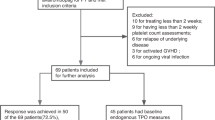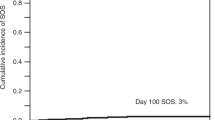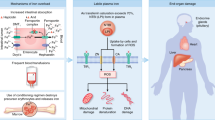Abstract
Circulating anticoagulants protein C (PC) and antithrombin III (AT) are markers of, and possibly involved in the pathogenesis of, significant organ dysfunction, in patients undergoing autologous peripheral blood stem cell (PSBC) or autologous bone marrow (BM) transplantation. The effect of the stem cell source, the use of hematopoietic growth factors (GFs), and the specific preparative regimen on the incidence of organ system dysfunction or on post-transplant levels of circulating anticoagulants has not been well studied. We analyzed 205 patients in an attempt to correlate organ dysfunction and AT and PC deficiencies with these transplant-specific factors (78 BMT with GM-CSF after transplant, 95 PBSCT without GM-CSF after transplant, and 32 PBSCT with GM-CSF after transplant). Patients transplanted with PBSC had a lower incidence of pulmonary dysfunction (20 vs 40%, P = 0.006) and liver dysfunction (4 vs 13%, P = 0.05) than patients receiving BM. The use of GF after transplant did not influence the development of subsequent organ dysfunction. In multivariate analysis, the stem cell source was again predictive of pulmonary dysfunction. In contrast, although patients transplanted with PBSC also had a lower incidence of PC deficiency (50 vs 81%, P < 0.01) and AT deficiency (20 vs 54%, P < 0.01) as compared with patients receiving BM, use of GM-CSF after transplant was a more significant risk factor for the development of anticoagulant deficiency (PBSC with GF vs PBSC without GF: PC deficiency 50 vs 78%, P = 0.007; AT deficiency 20 vs 47%, P = 0.005). In the multivariate analysis GM-CSF use was the only significant risk factor for development of anticoagulant deficiency. Since the clinical significance of anticoagulant deficiency has been well shown, further studies examining these effects of hematopoietic GFs appear warranted.
This is a preview of subscription content, access via your institution
Access options
Subscribe to this journal
Receive 12 print issues and online access
$259.00 per year
only $21.58 per issue
Buy this article
- Purchase on Springer Link
- Instant access to full article PDF
Prices may be subject to local taxes which are calculated during checkout
Similar content being viewed by others
Author information
Authors and Affiliations
Rights and permissions
About this article
Cite this article
Gordon, B., Haire, W., Ruby, E. et al. Factors predicting morbidity following hematopoietic stem cell transplantation. Bone Marrow Transplant 19, 497–501 (1997). https://doi.org/10.1038/sj.bmt.1700684
Received:
Accepted:
Issue Date:
DOI: https://doi.org/10.1038/sj.bmt.1700684
Keywords
This article is cited by
-
Transfer of the hematopoietic stem cell transplant patient to the intensive care unit: does it really matter?
Bone Marrow Transplantation (2006)



